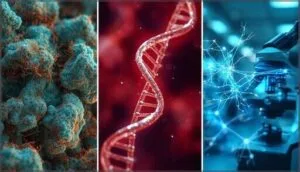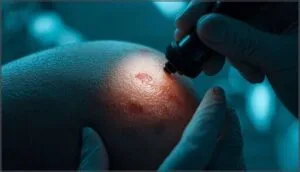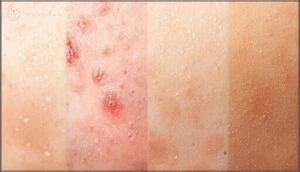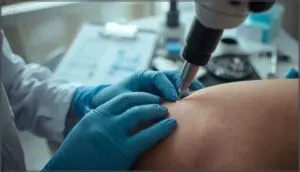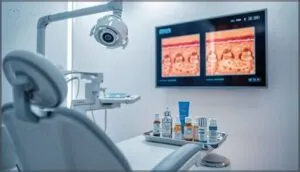This site is supported by our readers. We may earn a commission, at no cost to you, if you purchase through links.
Your skin rebels in dozens of ways—sometimes with angry red patches that refuse to fade, other times with persistent bumps that undermine your confidence at every mirror. Fifty million Americans battle acne alone each year, while eczema, psoriasis, and rosacea add millions more to the ranks of those searching for relief.
The frustration multiplies when you realize that what works brilliantly for your colleague’s rosacea might worsen your own symptoms, because skin conditions treatment options aren’t one-size-fits-all solutions.
Understanding the full spectrum—from prescription biologics that target specific immune pathways to the strategic use of over-the-counter moisturizers—gives you the control to build an effective treatment plan. The distance between diagnosis and clear skin depends on matching the right intervention to your specific condition and symptoms.
Table Of Contents
Key Takeaways
- Matching treatment to your specific condition matters more than relying on remedies that worked for others, since what clears one person’s rosacea might worsen your symptoms due to the individualized nature of inflammatory skin disorders.
- Early diagnosis through proper dermatological assessment dramatically improves outcomes, with dermatologists achieving 98% accuracy for common conditions while advanced tools like dermoscopy increase melanoma detection rates by 2.6-fold.
- Treatment timelines require patience as most therapies show improvement within 4–12 weeks, though chronic conditions like acne, eczema, and psoriasis typically cycle through remission and relapse rather than achieving permanent cures.
- Access gaps remain significant with over 60% of U.S. counties lacking dermatologists, though telemedicine and AI diagnostic tools now bridge healthcare disparities by delivering specialist-level care to underserved populations.
Common Skin Conditions and Their Causes
Your skin tells a story, and sometimes that story includes conditions that disrupt your daily life. From inflammatory disorders like acne and eczema to more serious concerns like skin cancer, understanding what you’re dealing with is the first step toward effective treatment.
Let’s break down the most common skin conditions you might encounter and what causes them.
Acne, Eczema, Psoriasis, Rosacea
You’ll encounter four main inflammatory conditions in your skin care routines: acne, eczema, psoriasis, and rosacea. Acne affects 50 million Americans annually through blocked follicles and bacterial buildup. Eczema creates dry, itchy patches that crack and swell. Psoriasis produces scaly, inflamed plaques. Rosacea causes facial flushing and persistent pimples.
Each condition requires targeted disease management based on your specific symptoms and treatment outcomes. Understanding rosacea treatment options is essential for effective skin care.
Infectious, Autoimmune, and Genetic Skin Disorders
Beyond inflammatory conditions, you’ll face three distinct categories requiring specialized dermatology expertise.
Infectious skin diseases—viral and fungal—accounted for 84.7 million new cases globally in 2021, manageable through infection control and targeted antibiotics.
Autoimmune skin conditions like lupus demand immunotherapy and biologics.
Genetic skin disorders affect 1 in 4,000 to 19,000 individuals, diagnosed through skin biopsy and genetic testing for proper skin disease management.
The global burden of fungal skin diseases is a significant concern, with rising fungal skin issues.
Skin Cancer and Precancerous Lesions
Skin cancer represents a stark departure from inflammatory and infectious disorders. You’re looking at 104,960 new melanoma cases expected in 2025 alone, plus thousands of basal cell carcinoma and squamous cell carcinoma diagnoses. Cancer screening through skin biopsy allows tumor removal before progression.
Three precancerous lesions demand vigilance:
- Actinic keratosis—treated with cryotherapy or topical chemotherapy
- Dysplastic nevi—monitored for melanoma transformation
- Bowen’s disease—requiring immunotherapy options when surgical excision isn’t feasible
Recognizing Skin Condition Symptoms
Your skin often signals when something’s wrong, but knowing what to watch for makes all the difference. Some symptoms appear suddenly and demand immediate attention, while others develop gradually over weeks or months.
Understanding these warning signs helps you decide when to seek professional care and what information your dermatologist will need.
Discoloration, Rashes, and Lesions
Your skin speaks volumes when something’s wrong. Discolored patches—whether hyperpigmentation from sun exposure or melanin disorders triggered by hormones—can signal underlying issues. Rashes appear in 11% of certain cancer therapy patients, while skin lesions account for 13.1% of hospital admissions, with 97.4% stemming from infections like cellulitis or herpes zoster.
| Symptom | Common Cause |
|---|---|
| Hyperpigmentation | Sun exposure, hormonal changes, post-inflammatory skin inflammation |
| Rashes | Infections, medications, systemic illness |
| Lesions | Bacterial infections, viral outbreaks, trauma |
Recognizing these patterns helps you seek timely rash treatment or lesion removal before complications develop.
Dryness, Peeling, and Itching
When your skin barrier breaks down, you’ll notice it fast. Worldwide, dry skin affects 29% to 85% of people, with women reporting sensitivity more often than men. Peeling stems from allergic reactions, infections, or conditions like atopic dermatitis and psoriasis. Itchy skin? New biologics like dupilumab deliver itch relief in 57% of chronic cases.
Key triggers you can’t ignore:
- Skin inflammation from eczema or contact dermatitis
- Moisturizer effects proven within four weeks using ceramide creams
- Dry skin causes including age (risk increases 1.04x yearly) and environmental irritants
- Peeling remedies targeting fungal infections and immune disorders
Skin lesions and pigmentation changes often accompany these symptoms, signaling deeper issues that demand your attention.
Hair Loss and Other Physical Changes
Hair thinning affects 80 million Americans—and you’re probably noticing more than strands circling the drain. Alopecia areata, autoimmune disorders, and hormonal changes can trigger baldness patterns you won’t ignore. Scalp health dictates hair regrowth potential, especially when skin conditions overlap with follicle dysfunction.
| Hair Loss Pattern | Primary Cause | Alopecia Treatment Focus |
|---|---|---|
| Patchy loss | Alopecia areata (autoimmune) | Corticosteroid injections |
| Diffuse thinning | Nutritional deficiencies | Vitamin D, iron replenishment |
| Complete loss | Chemotherapy (40–100% cases) | Scalp cooling, post-treatment regrowth protocols |
| Permanent changes | Radiation, severe autoimmune | Baldness prevention strategies, early intervention |
Chemotherapy drops hair density from 138.7 to 12.1 hairs/cm² after just two cycles. Taxane-based regimens increase permanent loss risk eightfold. But here’s your control: early recognition changes outcomes dramatically.
Diagnosing Skin Conditions
Getting to the root of a skin condition starts with an accurate diagnosis. Your dermatologist will use a combination of techniques to understand what’s happening beneath the surface and rule out other possibilities.
Here’s how the diagnostic process usually unfolds.
Physical Examination and Patient History
Your dermatologist’s diagnostic accuracy hinges on two fundamental tools: a thorough medical interview and careful skin inspection. Clinical assessment starts with your dermatologic history—when symptoms began, what triggers you’ve noticed, your occupational exposures—then moves to examining every visible inch of your skin. This combination catches conditions you mightn’t even realize you have.
- History reveals hidden clues: Details about symptom chronology, lifestyle factors, and environmental exposures guide your dermatologist toward the correct diagnosis, especially for conditions mimicking each other.
- Physical examination detects the unexpected: Over 25% of skin conditions are identified through inspection alone, not patient reporting, making thorough skin checks essential.
- Accuracy matters profoundly: Dermatologists achieve 98% diagnostic accuracy for common disorders through proper clinical assessment, dramatically reducing misdiagnosis rates that plague primary care settings.
Imaging and Additional Diagnostic Tools
When physical examination alone isn’t enough, your dermatologist deploys sophisticated diagnostic imaging to see what the naked eye can’t. Dermoscopy techniques improve melanoma diagnosis odds 2.6-fold, while confocal microscopy cuts unnecessary excisions by 43%.
AI diagnostic tools now boost non-specialist accuracy in teledermatology from 48% to 58%. These biopsy methods and skin disease diagnosis technologies guarantee you won’t face delayed or missed skin conditions.
Medical Treatments for Skin Conditions
Once you’ve identified your skin condition, the next step is choosing the right treatment. Your dermatologist will tailor a plan based on your diagnosis, symptom severity, and how your skin reacts to different approaches.
Here’s what modern medicine offers to help you regain control of your skin health.
Topical and Oral Medications
Choosing between topical medications and oral medications isn’t just about convenience—it’s about matching the right dosage forms to your condition’s severity. Treatment outcomes depend heavily on medication adherence, which research shows is markedly lower with medicated creams and ointments than steroid pills. Here’s what you need to know:
- Topical medications deliver higher skin concentrations with fewer systemic side effects
- Oral medications offer better adherence in chronic conditions
- Drug interactions matter less with topical treatments
Antibiotics, Steroids, and Antihistamines
You’ll find antibiotics, steroid pills, and antihistamines prescribed for different reasons—but effectiveness varies dramatically. Dermatologists write 8.2 million oral antibiotic prescriptions annually, yet antibiotic resistance in acne bacteria jumped from 20% to 62% between 1978 and 1996.
Steroid alternatives like ruxolitinib now match traditional steroids without atrophy risks, while antihistamine efficacy for eczema remains surprisingly limited despite widespread use.
Laser Therapy and Advanced Procedures
When topical treatments aren’t enough, laser therapy offers a new approach. Pulsed dye laser achieves 57–82% response rates for psoriasis, while photodynamic therapy clears 70.2% of actinic keratosis lesions at four weeks.
Fractional lasers target acne scars and sun damage with minimal downtime—though laser skin resurfacing costs $500–$3,000 per session.
Excimer lasers require fewer visits than traditional phototherapy, and low-level therapy accelerates healing for burns and UV damage.
Biologics and Targeted Therapies
Biologic agents represent a significant advancement for autoimmune disease management—targeting specific immune pathways rather than suppressing your entire system.
For moderate-to-severe psoriasis, these targeted prescription medications achieve 44–65% PASI 75 response rates at 12–24 weeks, with anti-IL-17A agents delivering enhanced skin clearance.
Treatment outcomes remain strong at 100 weeks, giving you sustained relief when conventional medications for skin diseases fall short.
At-Home and Preventive Care Options
You don’t always need a prescription to take control of your skin health. Simple, consistent habits at home can prevent flare-ups, protect against damage, and support your skin’s natural healing process.
Let’s look at three practical areas where you can make a real difference on your own.
Over-the-Counter Creams and Gels
You don’t always need a prescription to reclaim control over your skin. Medicated creams and moisturizers can deliver real treatment outcomes when you choose wisely. Consider these over-the-counter skin care products:
- Benzoyl peroxide gel formulations (2.5–10%) for acne—proven cream efficacy with minimal skin irritation
- Hydrocortisone for inflammation
- Colloidal oatmeal moisturizers for eczema
- Adapalene gel for breakouts
- Ceramide-based creams to strengthen your barrier
OTC product safety remains excellent, with adverse events below 0.014%.
Sun Protection and Skin Hygiene
Beyond targeted treatments, you reclaim power through daily prevention. Sunscreen application with SPF 30 blocks 97% of UVB rays—reducing melanoma incidence by half when used consistently.
Pair that UV protection with hand hygiene: wash for 20 seconds, then lock in moisture with fragrance-free cream containing petrolatum.
These twin pillars of sun protection and skin hygiene strengthen your skin barrier while preventing infections and sun damage before they start.
Diet, Hydration, and Lifestyle Modifications
Your daily choices—what you eat, drink, and how you manage stress—directly influence your skin’s healing capacity. Wellness strategies and nutrition therapy complement medical treatments by reducing systemic inflammation.
- Dietary Planning: Reduce high-glycemic foods and dairy; increase omega-3s and antioxidants to calm acne and psoriasis
- Hydration Tips: Drink 2,000 mL water daily for improved barrier resilience
- Lifestyle Changes: Exercise 150 minutes weekly to lower inflammation
- Stress Management: Practice mindfulness and maintain consistent sleep routines
Access to Care and Emerging Treatment Trends
Getting the right treatment for your skin condition depends on more than just knowing what works—it also depends on whether you can actually access the care you need. Where you live, how much support is available in your community, and what new tools are emerging all play a role in your treatment journey.
Let’s look at how access to dermatologic care is changing and what innovations are shaping the upcoming era of skin disease management.
Dermatologist Availability and Telemedicine
Finding a dermatologist shouldn’t feel like searching for a needle in a haystack, yet over 60% of U.S. counties have none. The dermatologist shortage hits rural areas hardest, where you might wait over a month for care.
That’s why telemedicine benefits matter—virtual consultations bridge healthcare disparities, giving you real-time access to specialists who can diagnose and adjust treatment without the long drive.
Innovations in Skin Disease Management
Artificial Intelligence now analyzes suspicious lesions with near-90% accuracy, slashing wait times by 30%. Digital Diagnostics paired with high-resolution dermoscopy catch melanoma earlier—22% more cases intervened before progression.
Laser Therapies like fractional lasers and IPL target scars and pigmentation with fewer side effects, while Biologic Agents such as lebrikizumab achieve 75% improvement in eczema severity.
Personalized Medicine through AI-driven treatment algorithms transforms Skin Disorders Management, making Dermatological Conditions easier to control with precision-targeted Skin conditions treatment and strong Skin disease prevention strategies.
Addressing Gaps in Low-Resource Settings
When dermatologists are scarce—less than 1 per million in many regions—Telemedicine Solutions and Rural Outreach close the gap. Community Training prepares local providers to manage 70% of skin conditions with Low-Cost Treatments under $1 annually.
Stronger Healthcare Infrastructure and targeted Dermatology Research expand skin disorders management.
Your skin care shouldn’t depend on geography—Treatment access must become universal.
Quality skin care should be a universal right, not a privilege determined by where you live
Frequently Asked Questions (FAQs)
How long does treatment take to work?
Like waiting for spring after winter, your skin’s healing journey unfolds at its own pace. Most treatments show improvement within 4–12 weeks, though therapy duration varies by condition severity and response rates.
Can skin conditions be cured permanently?
Most chronic skin conditions can’t be cured permanently. Acne, eczema, psoriasis, and rosacea usually experience remission periods followed by relapse.
However, early-detected skin cancer often achieves permanent recovery with treatment outcomes exceeding 99% survival.
What are the side effects of treatments?
Treatment side effects vary by therapy type. Topical reactions include skin thinning and redness, while systemic effects may cause infections or organ complications.
Drug interactions and adverse events require careful monitoring to prevent treatment resistance.
How do I choose the right treatment?
Your dermatologist will evaluate your medical history, skin type, and risk factors to match you with effective, evidence-based treatment options—balancing efficacy, cost, and your lifestyle for best possible outcomes.
Are natural remedies effective for skin conditions?
Natural remedies can help mild skin conditions, but they won’t replace medical treatment for serious cases.
Tea tree oil, chamomile, and dietary changes show promise, though you’ll need patience and realistic expectations.
Conclusion
Picture your reflection meeting you with confidence rather than concern—that transformation begins when you connect your specific symptoms to the right intervention.
The full range of skin conditions treatment options, from precision biologics to strategic daily care, puts you in command of your outcome.
Don’t navigate this alone: your dermatologist translates complex protocols into tailored action plans that turn persistent problems into manageable conditions, and frustration into measurable progress.



